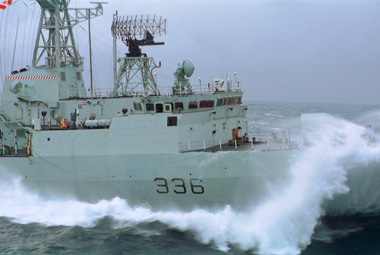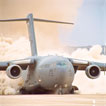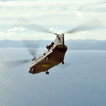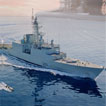Equipment : The Canadian Navy Frigates
Operation HESTIA is the name given to the Canadian Forces’ contribution to Canada’s response to the catastrophic earthquake that struck Port-au-Prince, Haiti on 12 January 2010. The operation was part of a Canadian government effort led by Foreign Affairs and International Trade Canada. The naval task force was composed of HMCS Athabaskan with an embarked Sea King helicopter and HMCS Halifax.
Halifax-Class Frigate
- The interior of a warship is a maze of decks, corridors and ladders connected by watertight doors, and hatches; all designed to help keep the ship afloat in the event of an attack.
- On the hanger/flight deck, aircrews ensure the Sea King helicopter can be in the air in practically all weather, day or night.
- The Phalanx 20mm Close-in weapon system is capable of dealing with missiles or engaging small, high-speed, highly maneuverable boats, helicopters and low-performance aircraft.
- Replenishment at Sea (RAS): Keeping the Navy ships mobile anywhere in the world means being able to refuel and re-supply at sea.
- Frigates are outfitted with RHIB (Rigid Hulled Inflatable Boat).
- The Water Desalination system converts seawater info portable water for drinking, cooking and washing.
- Warships are outfitted with radar systems used for aircraft detection, surface radar, weapons fire control, and surface to air guided missile vertical launching system.
- The ship is navigated and steered from the bridge. It is always fully staffed when the ship is at sea.
Ship’s Crew
People are the Navy’s greatest asset, working night in and day out off our coasts … and in distant seas. The Navy has approximately 8,500 regular and 5,100 reserve sailors, along with 5,300 civilian personnel. What are some of their jobs?
- A Boatswain (Bos’n) pilots a Rigit Hulled Inflatable Boat (RHIB) ashore, handles small arms, and helps with replenishments at sea.
- A Sea King helicopter pilot participates in many different missions, including surface surveillance, anti-submarine warfare, helicopter delivery services and medical evacuations.
- Weapons technicians supervise maintenance of naval weapons such as missile systems and guns. Their work requires a great deal of concentration, as they handle volatile weapons and ammunition.
- A Naval Communicator’s duties include using a flashing light (known as a Signaling Lantern), flag hoisting, and semaphore (signaling by hand using two small flags). They listen for distress signals and coded signals from Fleet Tactical, which they decode and report to the Officer of the Watch.
- The navigating officer’s primary duty is to ensure the safe navigation of the ship, while conducting long and short-term planning for deployments and exercises.
- Medics provide medical support to the crew, emergency first aid, work with other medical agencies in foreign ports and on board other ships in the Battle Group.
- A Naval Electronics Technician repairs passive and active sonar (the machine that goes “ping”), and navigation systems such as the GPS (global positioning system), compasses, etc. S/He also maintains computers, the ship’s combat and control system, and desktops/laptops.
- A bridge Watchkeeper is the Captain’s representative on the bridge, since the Captain cannot be there 24 hours a day. Responsibilities include: the safe navigation of the sip, collision avoidance, and the coordination of all shipboard activities to ensure the safety of all personnel and equipment.




